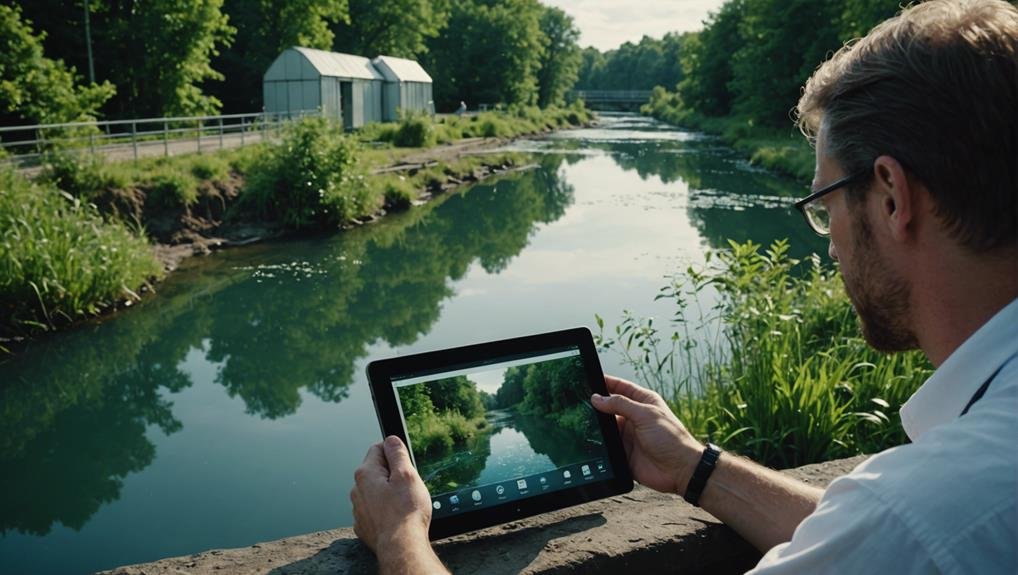Consistent water quality monitoring brings many benefits. By regularly checking water quality, we can quickly identify harmful contaminants, preventing waterborne illnesses and ensuring that our water is safe to consume.
Some of the links in this article may be affiliate links. If you make a purchase through these links, we may earn a small commission at no extra cost to you. Thank you.
This proactive approach also helps in safeguarding the environment by detecting pollution early, which in turn preserves aquatic ecosystems and maintains biodiversity. Furthermore, monitoring water quality allows for better management of water resources, informed decision-making, and preparedness for potential disasters.
Economically, consistent monitoring leads to lower healthcare costs and helps avoid expensive clean-up operations. Moreover, it fosters community engagement, builds public trust through transparency, and supports scientific research by providing valuable data.
Recognizing these advantages underscores the importance of ongoing water quality checks, offering us even more to gain as we delve deeper into the subject.
Protecting Public Health
Regular monitoring of water quality is crucial in detecting harmful contaminants like lead or bacteria early on to prevent serious health risks. By consistently testing our water, we can identify issues before they escalate, ultimately safeguarding public health.
Waterborne diseases, such as cholera or giardiasis, can have devastating consequences if not promptly detected and managed. Therefore, monitoring systems play a vital role in ensuring the safety of our water supply.
Implementing strict water quality standards helps us keep these contaminants in check. These standards establish limits for acceptable levels of various substances, guaranteeing that our water remains safe for consumption and other uses. Regular testing enables us to compare the current water conditions against these standards, making it easier to take necessary actions when required.
Safeguarding the Environment
Monitoring water quality is crucial for protecting the environment and preserving aquatic ecosystems. By regularly checking for pollutants, we can prevent long-term damage and maintain the health of our water bodies.
Early detection of pollution helps us take corrective actions before harm is done, safeguarding the diverse species that rely on these habitats. This proactive approach ensures the balance of our ecosystems and promotes biodiversity.
Through consistent water quality monitoring, we can sustainably manage our water resources and support the well-being of aquatic life. By identifying and addressing pollution sources early on, we can prevent environmental degradation and keep our ecosystems vibrant and functional.
This proactive stance not only benefits the various species that inhabit these habitats but also contributes to the overall health of our environment.
In essence, regular water quality monitoring is an essential tool for environmental protection. By implementing early warning systems and staying vigilant in our monitoring efforts, we can ensure the longevity and vitality of our water bodies.
This proactive approach is key to maintaining the delicate balance of our ecosystems and preserving biodiversity for future generations.
Optimizing Water Management

Consistent water quality monitoring is essential for optimizing water management and ensuring the sustainable use of this vital resource. By regularly monitoring water quality, we can detect contamination sources early, enabling us to take prompt actions to prevent issues from worsening. Evaluating key parameters helps us maintain safe and sustainable water for all purposes.
The data collected from monitoring efforts allows us to make data-driven decisions, improving the efficiency of our resource management. Having accurate and timely information empowers us to make informed choices that protect water quality in the long run. This proactive approach not only helps in averting potential problems but also enhances our ability to respond effectively to changing conditions.
Communities benefit greatly from consistent water quality monitoring as it leads to enhanced disaster preparedness and early warning systems. These systems enable us to anticipate and mitigate the impacts of natural disasters, ensuring the safety and well-being of the community.
Furthermore, maintaining high water quality standards through regular monitoring instills public confidence in our water supply. When people trust that their water is safe, it boosts economic growth and improves overall community well-being. In essence, consistent water quality monitoring is crucial for optimizing water management and securing a sustainable future.
Reducing Economic Costs
Consistently monitoring water quality helps save money by preventing waterborne diseases and contamination incidents. Early detection of potential issues through regular monitoring can help avoid costly cleanup expenses and regulatory fines.
This proactive approach also attracts investments to areas with high water quality standards, stimulating local economies and creating job opportunities. Additionally, maintaining clean water helps extend the lifespan of infrastructure, reducing the need for frequent repairs and associated costs.
Promoting Community Involvement

Protecting our water resources can be greatly enhanced by involving our communities in the monitoring process. When community members actively participate in monitoring water quality, they develop a stronger sense of ownership and responsibility towards their local water sources. This involvement not only increases awareness of water issues but also fosters a culture of accountability among residents, leading to more sustainable water management practices.
Community engagement in water quality monitoring also improves the accuracy of data collection. With citizens actively involved, monitoring efforts can cover a wider area and be conducted more frequently, resulting in more reliable data. This collaborative approach ensures that our monitoring initiatives are thorough and precise, providing valuable insights for effective water resource management.
Furthermore, involving communities in monitoring initiatives not only strengthens bonds among residents but also promotes environmental stewardship. By working together towards a common goal, communities become more united and informed, enabling better decision-making for sustainable water management practices. This active engagement not only helps protect our water resources but also nurtures a culture of care and responsibility towards our environment.
Meeting Regulatory Standards
Consistent water quality monitoring is crucial to ensure compliance with regulatory standards. By regularly testing water quality, we uphold the legal requirements that safeguard public health and the environment. This proactive approach helps us maintain high water quality by staying within acceptable contaminant limits.
Monitoring water quality not only helps us meet standards but also prevents costly penalties for non-compliance. By promptly addressing potential issues through monitoring, we can avoid fines and other punitive measures that could harm our finances and reputation.
The data collected from our monitoring efforts serves as solid proof of our commitment to water quality regulations. This information is vital when demonstrating compliance during audits or inspections by regulatory authorities. Through ongoing water quality monitoring, we can confidently show that we're meeting all necessary requirements.
Improving Emergency Response

Consistent water quality monitoring plays a crucial role in enhancing our emergency response capabilities. Real-time data from monitoring systems enables us to promptly detect contamination events, which is vital for being prepared for emergencies. Detecting water quality issues early on allows us to take immediate action to protect public health. This proactive approach ensures that we can swiftly respond to any potential threats, minimizing the impact on the community.
Continuous monitoring offers several benefits. Firstly, real-time data helps us identify contamination events as soon as they occur, leading to quicker responses. Secondly, monitoring data allows us to tailor specific strategies based on the type of contamination, increasing the effectiveness of our response efforts. Lastly, proactive monitoring supports well-informed and timely decision-making, which is essential for effective emergency management.
For example, utilizing advanced water quality monitoring systems like the XYZ system can provide us with accurate data in real-time, enabling us to respond swiftly to any contamination events.
Additionally, implementing proactive monitoring practices, such as routine sampling and analysis using the ABC technology, can significantly enhance our emergency response readiness.
Building Public Trust
Regular monitoring of water quality is essential to assure the public of the safety of their drinking water. By consistently checking the quality of water, we show our commitment to transparency and public health. This transparency helps build trust in the reliability of our water sources, as people feel confident knowing that any issues are promptly identified and addressed.
Sharing monitoring results and the actions taken further strengthens public trust. Communities value being kept informed about their water's status and the measures in place to maintain its safety. This open communication fosters trust and accountability, demonstrating that their well-being is a top priority.
Communities with robust monitoring systems exhibit a genuine dedication to public health and safety. This commitment encourages greater involvement in environmental conservation efforts. When people trust the existing systems, they're more likely to participate in initiatives that safeguard and conserve our water resources.
Supporting Scientific Research

By openly monitoring water quality, we not only build public trust but also contribute valuable data for scientific research on environmental trends. Consistent data collection enables us to monitor changes in aquatic ecosystems over time, offering insights into the impacts of various contaminants on these environments.
This data is essential for scientists studying the effects of pollutants on aquatic ecosystems, informing the development of effective environmental policies and sustainable practices. For instance, water quality monitoring data can uncover the presence of harmful substances like heavy metals or pesticides that pose threats to aquatic life and disrupt ecosystems.
The information gathered from monitoring plays a crucial role in shaping regulations to safeguard water resources, promoting practices that support long-term environmental well-being, and enhancing our ability to protect natural habitats. Through ongoing research supported by monitoring efforts, we continuously improve our methods for preserving these vital ecosystems.
Conclusion
Consistently monitoring water quality is crucial for safeguarding public health, protecting the environment, and optimizing water management. It helps in reducing economic costs, meeting regulatory standards, and promoting community involvement, which is essential for building public trust.
Effective monitoring not only improves emergency response but also supports scientific research.
In essence, conducting regular water quality checks ensures a safer, healthier, and more informed community. It's vital to prioritize this practice for the benefit of everyone.

